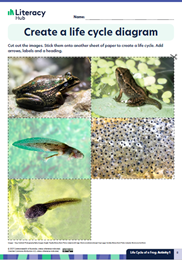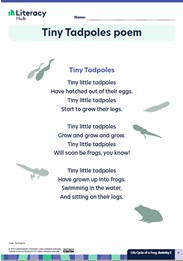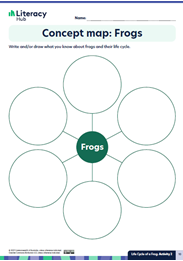Life Cycle of a Frog
This visual diagram describes the life cycle of a frog; tadpoles hatching out of their eggs, growing and developing into a froglet, and finally becoming an adult frog.
Back to the shared reading overview page
Text download
Life Cycle of a Frog as PDF (1.8MB) (opens in new window)
Life Cycle of a Frog as PowerPoint slideshow (7.5MB) (download)
Printable worksheets
|
|
|
|

Teaching & learning sequence
This teaching and learning sequence outlines classroom strategies for Life Cycle of a Frog, including:
- ways to incorporate the ‘Big Six’ core elements of reading development
- fun, engaging and adaptable student activities for a diverse range of abilities
- links to the Australian Curriculum.
| Text features | Cross-curriculum links to the Australian Curriculum |
|

First read
As a whole group, enjoy sharing the text and learning together.
Engage
Brainstorm to elicit what the students know about the topic. On a large chart, use students’ ideas to create a semantic word web about frogs (retain for later use).
Read aloud
Show the text and explain that it is a diagram that describes the life cycle of a frog. Talk through each of the photos and labels in the diagram, beginning with the eggs. Encourage students to make comments and ask questions about each stage. What happens during this stage? What happens next? Does anything surprise you? What else do you know about this stage of a frog’s life cycle?
Make meaning
Have students turn and talk with a partner about the text, and what they have learnt by viewing it. What did you learn about the life of a frog? Ask pairs to share their ideas, and discuss.
If required support English as an additional language or dialect (EAL/D) students, or other students by inviting them to role play each stage of the life cycle.
Revisit the semantic web created before viewing the text. Encourage students to demonstrate their new learnings by adding further information to it.
Encourage the students to think critically about the text. Why do you think the author chose to present this information as a diagram? Do you think it is easy to understand? What extra information could have been included? How else could this information have been presented?
Revisit the text
Return to the text several times to look more closely at different aspects of its content, structure and language features. This is a great vehicle for exploring the ‘Big Six’ of literacy in an integrated way, with all components linking to the same text.
Comprehension
Reading is about making meaning. Choose from these comprehension activities to help your students explore the text deeply, make personal connections, develop new understandings, and draw conclusions. The activities will also help students analyse the text, think critically about it and form their own opinions.
Talking text types (whole-group activity)
Discuss the text type and its purpose. What is the purpose of this diagram? What features does it have? What do the arrows tell us? Can all information be presented as a diagram?
Australian Curriculum links
Making personal connections (whole-group activity)
Encourage students to make personal connections with the text. Have you seen a frog before? Where was it? What did it look like? What stage of its life cycle was it in?
Australian Curriculum links
Summarising information (individual activity)
Have students summarise the life cycle of a frog using this printable worksheet. Have them cut out the images and stick them onto a second sheet of paper to form a cycle. Students can add a title, labels and arrows.
Print the Create a life cycle diagram worksheet.
Australian Curriculum links
Making links outside the text (whole-group activity)
Explain that all living things have a life cycle, and discuss other animal life cycles that the students know about.
In small groups students can use the frog life cycle as a model to create a life cycle about another animal on a large sheet of paper. Have groups take turns to share their life cycles with the whole class.
Australian Curriculum links
Phonological awareness (including phonemic awareness)
These activities will help students to hear the sounds and rhythms of language. Guide them as they explore syllables, onset and rime and listen for phonemes – the smallest units of sound within a word. Use the activities to help your students identify the phonemes in words and practise blending, segmenting and manipulating these sounds.
Hearing syllables (whole-group activity)
Use the labels in the text to explore syllables (for example, 1 syllable – ‘frog’, ‘egg’; 2 syllables – ‘tadpole’, ‘froglet’). Have students clap as they say each syllable in the word.
Revisit the semantic word web created before reading and use other ‘frog’ words to further explore syllables.
If it is appropriate, discuss the sounds in the syllables. Draw out and explain that each syllable in a word has a vowel sound in it.
Australian Curriculum links
Listening for long vowel sounds (whole-group activity)
Focus on the sounds in the words ‘life’ and ‘cycle’. Ask students to listen as you say each word, pronouncing each phoneme distinctly, for example:
- ‘life’ – l, long i, f
- ‘cycle’ – s, long i, c, l.
Highlight the sound that both of the words have in common (the long i sound). Have students think of other words with the long i sound, and share their ideas.
Australian Curriculum links
Phonics
Evidence shows that children learn best about the relationship between phonemes and graphemes through a daily structured synthetic phonics program (also known as systematic synthetic phonics). Knowing about these relationships will help students to decode, and this is crucial for their continued reading development.
In addition to your phonics program it is helpful to expose students to letter–sound relationships they come across in other contexts, such as during shared reading experiences. Choose activities that are relevant to your students so they can practise and reinforce already learnt concepts, so as to build automaticity in recognising letter-sound relationships.
Exploring initial sounds (whole-group activity)
Use the topic words from the text to reinforce letter–sound correspondences that your students have learnt. For example, point to the word ‘tadpole’. What sound do you hear at the beginning of this word? What letter represents this sound? What other words begin with the t sound? Discuss.
Repeat with other topic words and focus on their initial sounds (l as in ‘life cycle’, e as in ‘egg’, f as in ‘frog’).
If appropriate, focus on the end sound g as in ‘egg’ and ‘frog’.
Australian Curriculum links
Matching letters to sounds (whole-group activity)
If your students have learnt the long i sound and the letters that can represent it reinforce their knowledge by writing the words ‘life’ and ‘cycle’ on a chart. Ask students to identify the letter or letters in each word that make the long i sound and to underline it or them, for example ‘life’, ‘cycle’.
Write other words that have the long i sound in them. Invite students to underline the letter/s that represent this sound in each word.
Australian Curriculum links
Oral language
Oral language development begins at birth, and having a rich oral language is beneficial as a foundational and ongoing resource for literacy development. Oral language is embedded throughout the shared reading experience as students listen and respond to quality texts.
It is also valuable to involve students in specific activities that will continue to improve their oral language skills. Choose from these activities to help students develop and practise important communication skills.
Retelling (small-group activity)
Place students into small groups and ask them to draw a picture of each stage of a frog’s life cycle onto a large card or piece of paper. Have groups practise speaking about each stage of the life cycle, using their drawings as props. If appropriate, each student could be responsible for speaking about one stage of the cycle.
Have groups present their talk to the whole class.
Australian Curriculum links
A frog’s life (partner activity)
Present the following scenario: If you were a frog, what would you tell our class about your life? Be creative!
Using the think-pair-share strategy, have students think about this and then talk with a partner. Pairs then share their ideas with the group.
Australian Curriculum links
Fluency
Activities aimed at teaching and practising fluency are important for students on their journey towards becoming independent readers. Explicitly modelling fluency and providing opportunities for students to practise reading aloud are integral to this.
Funny frog poem (small-group activity)
Introduce the whole group to the poem Tiny Tadpoles by showing it on a large screen. Read the poem aloud, modelling fluent, phrased reading. Reread the poem and encourage students to join in when they feel confident.
You might like to talk about the punctuation used in the poem. Explain that it has upper-case letters at the beginning of each line, and that poems can be written this way. Point out that poems can also be written using sentence punctuation, with an upper-case letter at the beginning of each sentence and a full stop, exclamation mark or question mark at the end, and that occasionally poems are even written without punctuation.
Give copies of the poem to small groups, and allocate one verse for each group to practise reading fluently. Encourage students to think about the rhythm of the poem as they read.
Have groups present fluent reading of their verse to the whole class.
Print the Tiny Tadpoles poem.
Note: For more detailed information on teaching fluency see the Fluency section in Teacher talk.
Australian Curriculum links
Vocabulary
Having a rich, broad vocabulary assists students when they are tackling new texts. These vocabulary activities will help them to build their growing bank of words.
The activities introduce students to new Tier 2 and Tier 3 words, as well as exploring word families and a range of different word types.
Base word – cycle (whole-group activity)
Revisit the text and focus on the title. What does the word ‘cycle’ mean? Discuss and draw out that it is a sequence of events (or things that happen) repeated over and over again.
Discuss other uses of the word ‘cycle’. Draw out that it can be used as a verb (an action word), as in to cycle or ride a bike.
Write the word on a chart with various suffixes (for example, cycling, cycled, cycles, cyclist) and discuss how the meaning changes as each suffix is added. Model saying a sentence with each word in it.
Add the word part ‘re’ to the front of the word, and discuss its meaning. Repeat with the word part ‘bi’ as in bicycle. Talk about other words with cycle in them – for example, ‘tricycle’, ‘motorcycle’.
Australian Curriculum links
Animal babies (whole-group activity)
Draw up a T-chart with the headings: ‘Animal’ and ‘Offspring’. Write the words ‘frog’ and ‘tadpole’ in the columns on the chart.
Have students talk with their partner about other animals and their offspring that could be added to the table. Invite pairs to share their ideas and scribe their suggestions onto the chart (cow/calf, hen/chick, horse/foal, and so on).
Encourage students who speak a language other than English to share subject-specific words such as ‘frog’, ‘egg’ and ‘tadpole’ in their home language.
Australian Curriculum links
Reflecting on learning
Help students ‘bring it all together’ and reflect on their understandings by completing a graphic organiser either independently or with a partner.
Concept map
Discuss all the facts and information the students now know about frogs and their life cycle. Have students complete the concept map to show this knowledge.
Print the Concept map: Frogs worksheet.
For families - new for 2024!Reinforce your classroom learning by telling families in your class about Life Cycle of a Frog. Families can share the text at home and use the information provided to build knowledge and instill a love of reading. |


